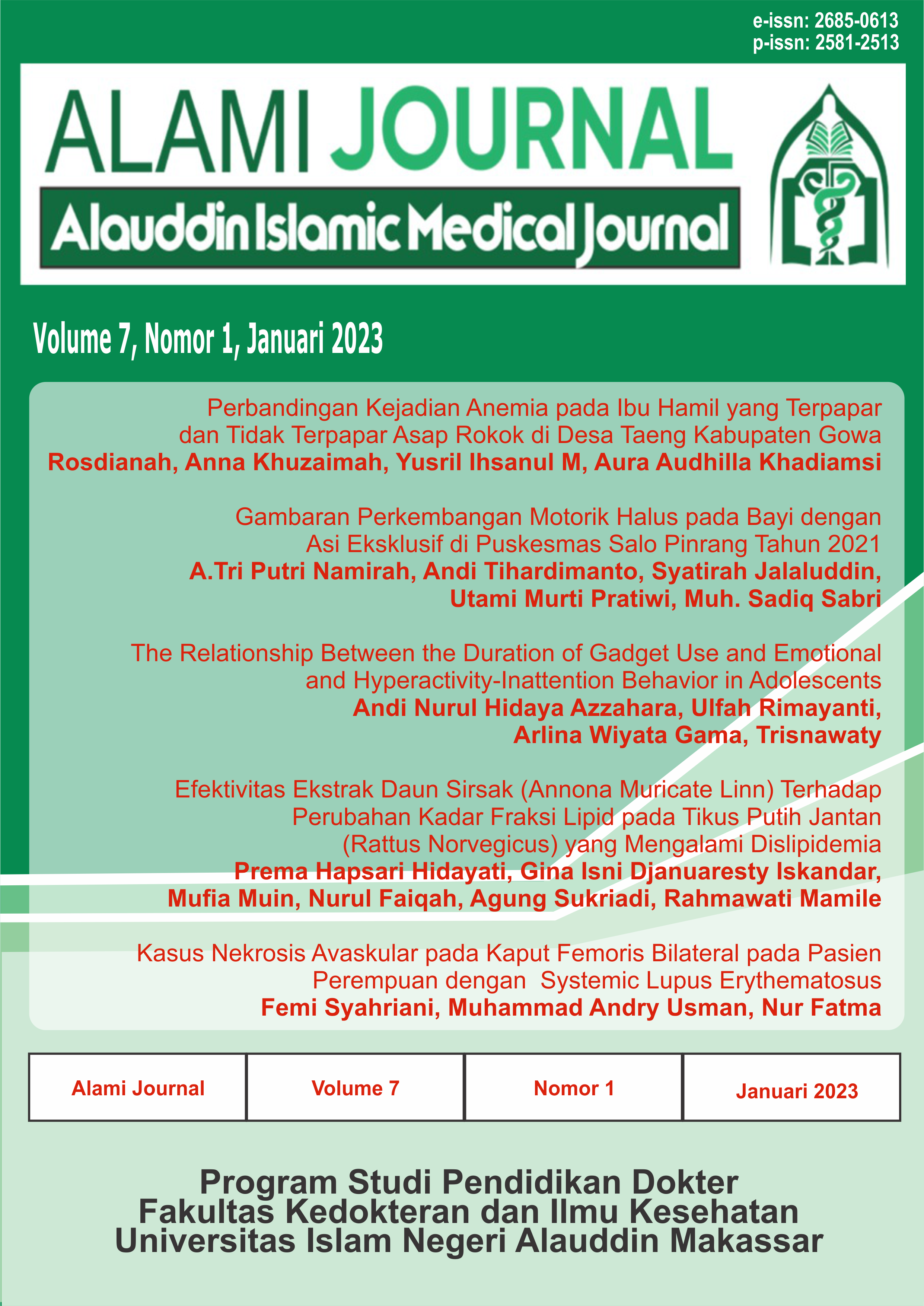The Relationship Between the Duration of Gadget Use and Emotional and Hyperactivity-Inattention Behavior in Adolescent
Abstract
Backgrounds Adolescence is a physical and mental development period that various factors could influence. Aims This research aims to determine the relationship between the duration of gadget use and emotional symptoms and hyperactivity disorder in adolescents. Methods This research is a cross-sectional study with a quantitative approach using the Strengths & Difficulties Questionnaire (SDQ) to determine adolescents’ emotional and hyperactivity-inattention behavior. This research is a correlational study in which 142 students at SMA Negeri 4 of Wajo Regency selected as research subjects. We analyze research data using the Chi-Square test with a significance level of 5%. Results The results of the Chi-Square test indicate that the p-value amount to 0.062 (emotional symptoms) and 0.170 (hyperactivity disorder). Emotional symptoms and hyperactivity-inattention indicate a p-value of >0.05 (more than 0.05). Conclusion From this research, there are differences between groups with different duration of gadget use and emotional symptoms, as well as groups with different duration of gadget use and hyperactivity-inattention in adolescents, but they were statistically insignificant.
References
Caskey M, Anfara ViA. Young Adolescents ’ Developmental Characteristics. Res Gate [Internet]. 2020;(October 2020). Available from: http://www.amle.org/Research/ResearchSummaries/DevelopmentalCharacteristics/tabid/1414/Default.aspx
Patton GC, Olsson CA, Skirbekk V, Saffery R, Wlodek ME, Azzopardi PS, et al. Adolescence and the next generation. Nature [Internet]. 2018;554(7693):458–66. Available from: http://dx.doi.org/10.1038/nature25759 doi: 10.1038/nature25759
Ministry of Communication and Information (Indonesian Government). Survey Penggunaan TIK. Jakarta: Kementerian Komunikasi dan Informatika; 2021.
Australian Government (Department of Health). Australian 24-Hour Movement Guidelines for Children and Young People (5 to 17 years). 2019;24.
Rukmana NIN, Ainy Fardana N, Dewanti L, Mujtaba F. Does the Intensity of Gadget Use Impact Social and Emotional Development of Children aged 48-72 Months? Al-Athfal J Pendidik Anak. 2021;7(2):135–44. https://doi.org/10.14421/al-athfal.2021.72-04
Sapardi VS. Hubungan penggunaan gadget dengan perkembangan anak usia prasekolah di PAUD/TK Islam Budi Mulia. MENARA Ilmu [Internet]. 2018;7(80):137–45. Available from: https://www.jurnal.umsb.ac.id/index.php/menarailmu/article/view/634
Alvina, Pratiwi. Gadget Playing Intensity and Suspected (ADHD) in Children. J Biomedika dan Kesehat. 2022;5(2):61–8. https://doi.org/10.18051/JBiomedKes.2022.v5.
Wahyuni AS, Siahaan FB, Arfa M, Alona I, Nerdy N. The relationship between the duration of playing gadget and mental emotional state of elementary school students. Open Access Maced J Med Sci. 2019;7(1):148–51. https://doi.org/10.3889/oamjms.2019.037
IDAI. Rekomendasi IDAI Selama Anak Menjalani Sekolah Dari Rumah. In: Committed in Improving the Health of Indonesian Children. 2020. p. 88.
Heryana A. Jumlah kelompok Fungsi Syarat data. Univ Esa Unggul. 2020;(May):1–20. https://doi.org/10.13140/RG.2.2.23266.15047
Mustamu AC, Hasim NH, Khasanah F. Factor Influence Mental in Adolescences. Int J Environ Sustain Soc Sci. 2020;36–40. https://doi.org/https://doi.org/10.38142/ijesss.v1i1.40
Amaltinga APM, Mbinta JF. Factors associated with depression among young people globally: a narrative review. Int J Community Med Public Heal. 2020;7(9):3711. https://doi.org/10.18203/2394-6040.ijcmph20203949
Pandia V, Noviandhari A, Amelia I, Hidayat GH, Fadlyana E, Dhamayanti M. Association of Mental Health Problems and Socio-Demographic Factors Among Adolescents in Indonesia. Glob Pediatr Heal. 2021;8(28). https://doi.org/10.1177/2333794X211042223
Surat S, Govindaraj YD, Ramli S, Yusop YM. An Educational Study on Gadget Addiction and Mental Health among Gen Z. Creat Educ. 2021;12(07):1469–84. https://doi.org/10.4236/ce.2021.127112
Vanitha SS, Javalkar SR. A study on prevalence and factors associated with depression among medical adolescent students. Natl J Community Med [Internet]. 2018;9(3):172–85. Available from: http://www.njcmindia.org/home/abstrct/1167/March
Preety R, Gayatri D, Priya J. Sleep Deprivation and Cell Phone Usage Among Teenagers. Drug Invent Today. 2018;10:2073–5.
Sarla GS. Excessive use of electronic gadgets: health effects. Egypt J Intern Med 2020 314 [Internet]. 2020;31(4):408–11. Available from: https://ejim.springeropen.com/articles/10.4103/ejim.ejim_56_19 doi: 10.4103/ejim.ejim
Rashid SMM, Mawah J, Banik E, Akter Y, Deen JI, Jahan A, et al. Prevalence and impact of the use of electronic gadgets on the health of children in secondary schools in Bangladesh: A cross-sectional study. Heal Sci Reports. 2021;4(4):1–9. https://doi.org/10.1002/hsr2.388
Setianingsih S. Dampak Penggunaan Gadget Pada Anak Usia Prasekolah Dapat Meningkatan Resiko Gangguan Pemusatan Perhatian Dan Hiperaktivitas. Gaster. 2018;16(2):191. https://doi.org/10.30787/gaster.v16i2.297
Copyright (c) 2023 Andi Nurul Hidaya Azzahara, Ulfah Rimayanti, Arlina Wiyata Gama, Trisnawaty

This work is licensed under a Creative Commons Attribution-NonCommercial-ShareAlike 4.0 International License.
Once an article was published in the journal, the author(s) are: granted to the journal right licensed under Creative Commons License Attribution that allows others to share the work with an acknowledgement of the work's authorship. permitted to publish their work online in third parties as it can lead wider dissemination of the work. continue to be the copyright owner and allow the journal to publish the article with the CC BY-NC-SA license receiving a DOI (Digital Object Identifier) of the work.


